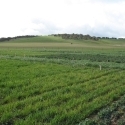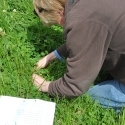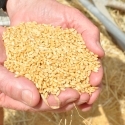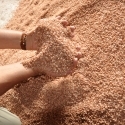01 Oct 2016
0 Potassium for sheep and beef pastures
Sheep and Beef Australia and New Zealand
 Beef cattle grazing on rainfed pastures
Beef cattle grazing on rainfed pastures
About Potassium
Potassium is one of the sixteen nutrient elements which is needed by plants for healthy growth. It is second only to nitrogen in the quantities required by plants.
Potassium is very mobile within plants, and performs a wide range of vital roles in plant systems, including photosynthesis, enzyme activation, stomatal control and transporting plant sugars.
Although potassium occurs naturally as up to 3.5% of the earth's crust, only a small proportion of it is available to plants. After many years of agricultural production, and removal of potassium in produce harvested from the field, even soils which were naturally well supplied will become depleted.
If soil potassium supplies are insufficient to meet plant requirements, supplementation by potash fertilisers - fertilisers containing potassium - is necessary to maintain healthy plant growth and a sustainable agricultural environment.
Potassium fertilisers can be an important addition to grazing systems because potassium is essential for sustaining productive pastures. It is particularly important for maintaining the legume component of mixed pastures, and a decreasing proportion of legume species can indicate that soil is lacking in potassium.
Unlike most other nutrients, potassium can be taken up in quantities far exceeding that necessary for plant growth without becoming toxic. This response, called luxury uptake, can be undesirable, particularly where produce is removed from fields or in pastures where nutrients are redistributed within paddocks through transfer to stock camps. Luxury uptake of potassium can also interfere in the supply of other nutrient elements.
On the other hand, inadequate uptake of potassium is also undesirable. Severe nutrient deficiencies can cause identifiable symptoms on plants. (See Deficiency Symptoms for more details). However, by the time nutrient deficiency symptoms are apparent, a considerable amount of yield potential has been lost.
This deficiency of a nutrient without obvious symptoms is called hidden hunger, and can be very costly. A program of regular soil and plant analysis and nutrient budgeting can ensure that hidden hunger does not go unnoticed.
Effects on Crops and Pastures
Potassium affects the yield and quality of crops and pastures. Where soil potassium is lacking, adding potassium fertiliser can improve the:
• size of kernels, seeds, fruits or tubers
• oil content of kernels
• resistance to bruising and breakdown of fruit in storage
• length, strength, fineness and colour of cotton fibre
• botanical composition of pasture, and many other plant characteristics.
Fertiliser Timing
The timing of potassium fertiliser application can affect the total annual pasture production, as well as the distribution of production throughout the year. Split applications of potassium fertiliser is recommended if high annual rates of potassium are used (>100kg/ha) in high rainfall areas, or where soils are prone to leaching.
Potassium Losses
The removal of animal products such as meat and wool is only responsible for a small proportion of overall potassium losses within grazing systems. Potassium can also be lost through leaching, runoff and soil fixation, and dung and urine transfer to non-productive areas of the farm like stock camps and yards. A rule of thumb is that higher stocking rates result in higher transfer losses.
Production Intensity and Economics
Intensity of the production system will determine if responses to potassium deficiency are likely, and if they will be economic. Production systems can be manipulated to capture the benefits of increased production resulting from potassium fertiliser use.
Move on for more information about potassium in pastures - see:




